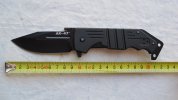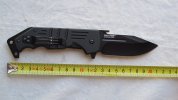This AK-47 was recently posted in the CS forum and the question was asked if it was real or fake. It was an obvious fake for those familiar, as the real ones are not liner-lock, and they don't have a flipper tab. But to those that say those differences mean it's technically not a counterfeit, I call BS. With CS markings, it was intended to deceive, plain and simple, and therefore absolutely a counterfeit.
View attachment 1310251 View attachment 1310252
I don't think anyone's saying that a product that's branded in an attempt to pass itself off as a genuine article isn't a counterfeit, whether it's an accurate copy or not. I've yet to see anyone on here say that selling cheap counterfeit knives in an attempt to rip-off unsuspecting customers is in any way justifiable. If your goal is to make people think they're getting a real product at a bargain price by selling a counterfeit, that's clearly a crime, and unlicensed use of trademarks is also unlawful.
The area that really divides people is how they'd feel about that same knife if it didn't have the markings. To some, the switch from back lock to a liner lock with a flipper tab is substantial enough to not be bent out of shape about it; some will say that we, as a community, shouldn't support companies whose designs are clearly modeled on existing products. Neither of these positions is wrong, and it's possible to agree with both. There are some very high-end clone and homage knives that could stand up to the real thing, and are worth their price in terms of quality and materials. There are many side-by-side comparisons of clone Shirogorovs against the real deal, and it's pretty much universally concluded that the $200+ clones are very nice knives.
Very few knives or knife features are patented. So replicating a knife is not a real issue, it is expected. But, the makers do have copyright and trademark protection and replicating either is nothing less than theft and fraud.
n2s
Copyright doesn't apply to "utilitarian" works, just "sculptural" and "aesthetic" ones. Despite what some people claim, there is no legal protection for the shape of a knife or blade. You'd only get copyright protection to the extent a feature/piece is purely sculptural or decorative with no functional or utilitarian value, which really limits the vast majority of knifemakers' ability to protect their ideas. This "Sculptural Knife Vase" by Chris Bathgate is one of the few "blades" (the blades are legitimately heat-treated and sharpened AEBL) I've seen that can legitimately claim copyright protection, but it's an actual sculpture rather than a tool.

Generally, there's no trademark coverage for functional aspects either, so they only really apply to wordmarks and logos in the knife world. The one sort-of exception to this is Spyderco's trademark for the Spydiehole, which they argued had become a brand signature (it's a relatively rare example of something that was patented and later allowed to be trademarked; in order to maintain the trademark, they are obliged to include a non-functional hole on their fixed blades).





